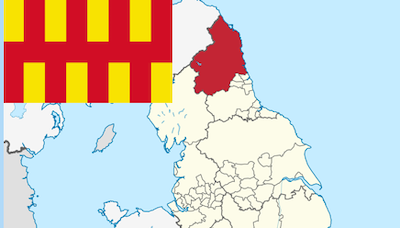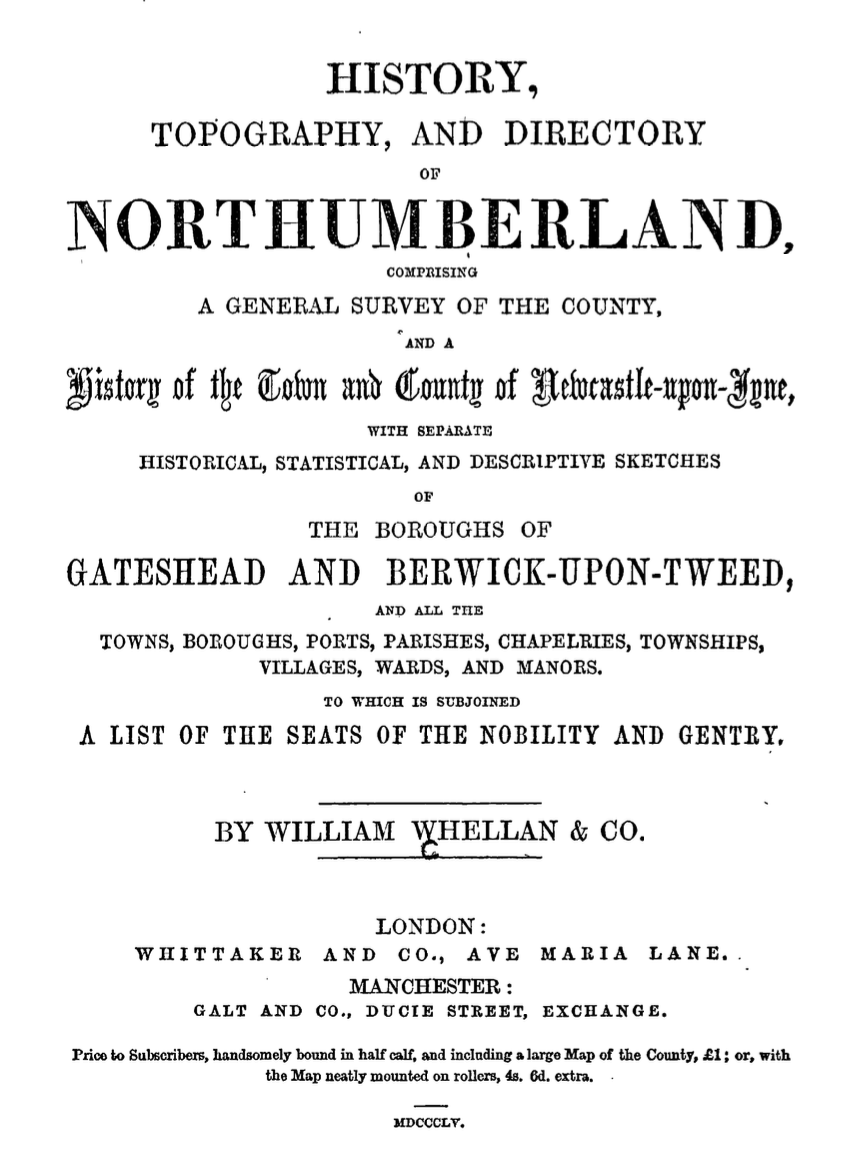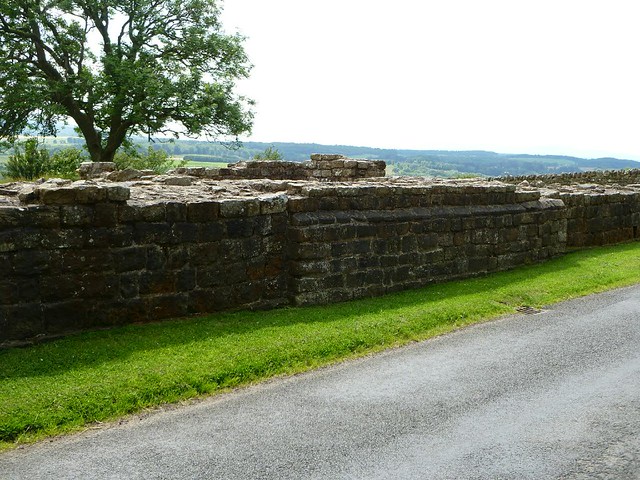Topics > Northumberland > Civil Parishes in Northumberland > Alnwick Town Council area > Alnwick Parish, 1855 > Geology of Alnwick
Geology of Alnwick
Extract from: History, Topography, and Directory of Northumberland...Whellan, William, & Co, 1855.
GEOLOGY
We are indebted to George Tate, Esq.,F.G,S., for the following article on the geology of this parish.
GEOLOGY. The mountains of Scotland are known to be much older than the Alps, and the whole island has probably a much less elevation now than belonged to its early age. Many of the rivers on the east coast of England, such as the Aln, the Coquet, the Tyne, the Wear, and others, have no flat alluvial estuary, but flow betwixt steep and abrupt banks down to the ocean. They are like fragmental or upper branches of large rivers. The east coast is a wasting shore generally, and the action of the sea, with a long and continued subsidence of the land, may have gradually wasted and submerged a large area of the country which existed previous to any written records of history, and far beyond the reach of tradition. The ruins of a submerged forest have recently been washed bare by the waves on the shore, near to Howick, and traces of this character exist on many other portions of the shores of England; betwixt the Mersey and the Dee, on the west, such remains are found. At Alemouth, properly Alnemouth, in the parish of Lesbury, the old burial ground has been washed away by the sea ; and with bones of men are found those of horses, supposed to have been slaughtered in border skirmishes.
The relative positions of the boulder formation, the carboniferous limestone, and the basaltic dikes or outbursts, are exemplified in a most interesting manner at Ratcheugh, about three miles from Alnwick. The basalt may there be seen interstratified with the limestone, having broken through the lower sedimentary beds : in one part it is intercalated betwixt them; in another part it covers them. The metam.orphic action of the basalt is very marked ; the limestone beds in contact with it have been changed into crystalline marble),and the shell into porcelaneous jasper. At Hawkhill, the estate of Earl Grey, a portion of the under-beds of the carboniferous limestone has recently been bared, for the purpose of obtaining the rock: the surface is found to be polished and scored with parallel groves, running north and south, exactly resembeling the polished and striated surfaces observed in Switzerland, on the flats and bottoms of the valleys occupied by glaciers. Volcanic rocks of basalt, greenstone, trachyte, porphyry, &c., are found in all parts of the earth's crust. They have ruptured every formation; and, where in contact, they have changed the character of all kinds of rocks. Chalk has been converted into granular marble, and coal into coke. They may be seen in narrow dikes, leagues in length, and sometimes in huge shapeless masses. The dikes have penetrated the divided strata from unknown depths, evidently in a fluid or semi-fluid state, as thin horizontal sheets are found intercalated between the regular beds, or overlaying them ; and in the vicinity of the larger masses the rocks axe broken, contorted, and thrown back into confusion. The county of Northumberland is traversed by several large dikes, and numerous smaller ones. These trappan rocks are by geologists considered to have had their origin in active volcanoes.
The polished surfaces and striated markings are also common over vast areas of the earth's surface, as are also blocks of stone, termed "erratic", some of which are a few inches, others several yards in diameter. They are strewed by thousands over Great Britain, and by myriads over the sandy countries of the north of Germany, in the valleys of Sweden, Denmark, Finland, Russia, and North America. Many of them have one side flat, polished, and grooved in the same manner as the surface of the rocks forming the regular strata. Icebergs, holding these stones imbedded, and being driven by the ocean-currents and wind over shoals where their surfaces would be rubbed and ground against the strata, would produce the appearance seen ; and glaciers are known to carry along with them fragments of rock of all sizes, which are rubbed and ground as the whole mass of ice descend. The geological phenomena observed near Alnwick are common to many countries on either side the intermediate equatorial and warmer regions - over vast areas of the globe. They speak of a cold climate, and of change.
The town. of Alnwick stands on the south bank of the Aln, at a considetable elevation above the bed of the river, on the boulder formation, or "northern drift," which in several parts of the county overlies the carbohifetous formation. The northern drift consists of many beds of sand, gravel, erratic boulders, and clay, irregularly interstratified with each other; it is of variable thickness. The following section, taken when water was bored for on the north-west outskirts of the town, will show the general character and succession of the formation :-
| Ft. | In. | |
|---|---|---|
|
Gravel |
7 | 0 |
|
Sharp sand |
3 | 6 |
|
Gravel |
3 | 6 |
|
Gravel and enatic boulders |
4 | 0 |
|
Tough red clay in which boulders are generally imbedded |
5 | 0 |
|
Sharp sand with water |
9 | 0 |
|
Below these were beds belonging to the carboniferous series, viz: |
||
|
Grey clay or shale |
23 | 6 |
|
Slaty sandstone |
13 | 0 |
|
Grey metal |
0 | 6 |
|
Sandstones ahd shale |
17 | 0 |
|
Total depth...... |
86 | 0 |
On the south-west part of the town the subsoil is very damp, being sand, saturated with water, resting on clay. Some of the buildings in this district, as for example the Scientific Institute, stand on piles driven into the sand. The river Aln, in portions of its upper channel, flows over sandstone beds; but opposite to the town, and for the most part of it’s course onward to the sea, il runs through portions of the northern drift, and passes over a sandy mud, and in some parts a gravelly channel. The mountain-limestone formation extends over the parish and neighbourhood of Alnwick ; it consists of limestones, calcareous shales, sandstones, coal, and carbonaceous shales, with ironstone nodules interstratified. The limestone and calcareous shales contain remains of corals, crinoids, molluscs, and fish, characteristic of the lower beds of the mountain limestone,
The sandstones and carbonaceous shales yield remains of plants identical with those found in the Newcastle coalfield, such as Stigmaria ficoides, and some species of calamites, lepidodendron, and sigillaria. The Northumberland mountain-limestone is of the same age, and presents similar characteristics, as that which is found in Fifeshire. This formation also extends over a wide area in Russia. The limestones worked in this parish produce lime of the best quality, and excellent sandstones for building purposes are abundant and accessible. The coal obtained in the neighbourhood is not well adapted for domestic use. The inclination of the mountain limestone strata in the county is varied, the angle depending chiefly on their relation to the porphyry of the Cheviot, from which they generally dip, yet modified, especially in the eastern part of the county, by basaltic dikes and outbursts, in the neighbourhood of which the beds are broken and contorted. Basaltic rocks overlying portions of the strata are found to the south-west of Alnwick. The rocks in Alnwick parish generally dip south-east.
Proceeding from the sea coast, in a line north-west, the strata rise towards Alnwick, and the relation of the beds in Alnwick parish to the contiguous formations may be distinctly seen. At Radcliff the coal measures, which are a continuation of the Newcastle coalfield, will be passed over. At Warkworth the millstone-grit will be found rising from beneath the coalfield. At Newton- on-the-Moor and Shilbottle, where one of the best seams of coal in the country is worked, the uppermost beds of the mountain-limestone rise up from below the millstone grit, and from beneath these again the Alnwick Moor lime- stones crop out. The chief beds of limestone in Alnwick parish appear in the elevated grounds at Hobberlaw and Alnwick Moor; but the hills to the north of Alnwick, and the highest hills on the moor, which are 800 feet above sea-level, are formed of masses of gritty sandstone. On the shore near Howick the limestone beds may be seen bent in curved lines, and the characteristic fossils of the formation may be obtained in abundance. On the declivity of the highest hills in Alnwick Moor, there are several springs of water, which, coming out of the sand-stone rocks, are remarkably bright. Along the acclivity of the hill ranging from Clayport Bank to Rugley, are several powerful springs, probably containing some portion of carbonate of lime, as the limestone beds are near to them. Some other springs in the neighbourhood of Alnwick are strongly impregnated with iron.










